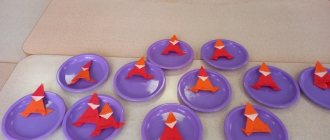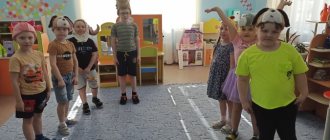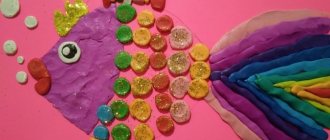The educational role of origami
Origami helps to spend leisure time and solve many educational problems .
By folding paper figures, you can develop in a child confidence in his abilities, creativity, love of art, and imagination. By improving finger movements and developing fine motor skills with the help of origami, you can influence intellectual and speech development. Exercises have a beneficial effect on memory formation. In the process, children remember the actions they perform and reproduce them in the future.
The educational role of origami is to develop independence and the formation of aesthetic taste.
The process of folding figures brings children pleasure . With the help of step-by-step actions, the child receives a car, plane, ship or frog that comes to life in his hands. Therefore, such activities are interesting to them.
Does your child do origami?
Not really
Paper is a universal constructor . It allows you to get a finished toy from an ordinary sheet. Educators use these activities in kindergartens and recommend repeating them at home.
Making crafts helps:
- develop perseverance;
- create positive feelings (after all, a toy can become a gift for loved ones);
- discipline;
- show creativity;
- favor theatrical, constructive and visual talents.
In kindergarten, origami helps prepare children for school. Classes contribute to the formation of important skills:
- the ability to listen carefully;
- take a responsible approach to the task and its implementation;
- reorient consciousness from the outcome of the task to the search for its completion;
- self-control;
- awareness of one's cognitive processes.
The main form of training is recommended to be carried out in small subgroups . Making toys requires precise finger work. The teacher needs to provide individual assistance to each child.
The main tasks of origami in the middle group:
- teach your child to design and be able to create three-dimensional crafts using this technique;
- develop finger motor skills;
- show creativity and artistic taste;
- instill patience and love of work.
When the child has formed and consolidated an idea of how to work with paper, his imagination will begin to manifest itself, and he will be able to follow the teacher’s verbal instructions. Making origami also helps with mathematical preparation. In the process of paper creativity, children study geometric shapes, including polygons, focusing on the sheet. Putting together crafts in a group helps develop communication skills and foster a desire to interact with peers and adults.
Planning classes on origami in the senior group. work program (senior group) on the topic
Thematic planning of origami classes. Senior group. September. Lesson 1. Let's play. Objectives: - to identify children’s ability to recognize and name geometric shapes; — to get interested in working with paper, to introduce one of its properties – creaseability. - teach how to divide a square by folding it into different numbers of equal possibilities: two rectangles, four triangles or squares; - strengthen small arm muscles; - cultivate accuracy.
Lesson 2. In a certain kingdom, in a paper state..... Objectives: - to interest children in making paper crafts in the origami style, to introduce some of them; — start introducing preschoolers to the history of the art of origami.
Lesson 3. Magic transformations of a paper square. Goals: -continue to teach children how to transform one paper figurine into another; - consolidate the ability to connect two parts of a craft by inserting them into one another; - develop imagination and constructive imagination; - form speech breathing.
Lesson 4. Butterfly. Goals: - to train children in the ability to recognize geometric shapes; - consolidate the ability to obtain a rectangle, triangle and smaller squares from a square; — introduce the making of simple crafts in the origami style by folding a square diagonally (the basic shape is “triangle”); - practice free choice of paper color when making a butterfly; - teach techniques for decorating butterflies with applique; - cultivate perseverance and accuracy.
October.
Lesson 1. Funny faces (puppy). Goals: - increase interest in classes through play; - learn to make a new toy by folding a square in different directions; - to arouse in preschoolers a desire to help the weak; — Strengthen the skills of decorative decoration of the finished figurine; - cultivate accuracy; - develop the eye; - strengthen small arm muscles;
Lesson 2. Mushroom-Amanita.Goals: - continue to teach children how to make crafts in the origami style; - introduce preschoolers to one of the methods of connecting parts - gluing; - help each child achieve the desired result; - cultivate independence.
Lesson 3. Mouse. Goals: -increase interest in origami activities through the game; - learn to make a toy by folding a square in different directions; - induce in preschoolers a desire to help the weak; - help each child achieve the desired result; - strengthen small arm muscles.
Lesson 4. Home
Goals:
— continue to teach children how to make crafts in the origami style; - learn to make a toy by folding a square in different directions; - induce in preschoolers a desire to help the weak; - help each child achieve the desired result; - strengthen small arm muscles.
November
Lesson 1. Grandmother
Goals:
- continue to teach children how to make a new toy by folding a square in different directions; — consolidate the skills of decorative decoration of the finished figurine; - cultivate perseverance and independence; - develop the eye.
Lesson 2. Grandfather. Goals: - improve the ability to work with paper, - continue to teach them how to make toys in the origami style, - develop constructive creativity in preschoolers; - cultivate accuracy and perseverance.
Lesson 3. Bunny. Goals: - increase interest in origami classes using game techniques; — consolidate the ability to follow the teacher’s instructions; - develop fine motor skills of the hands; - cultivate independence and accuracy.
Lesson 4 Chanterelle. Goals:
- continue to teach children how to make a new toy by folding a square in different directions; — consolidate the skills of decorative decoration of the finished figurine; - cultivate perseverance and independence; - develop the eye.
December Lesson 1. Wolf. Goals: - strengthen the ability to fold a square in different directions; — accustom to precise finger movements under the control of consciousness; - cultivate accuracy; -enrich the emotional sphere and vocabulary.
Lesson 2. Bear. Goals: - continue to teach children how to make a new toy by folding a square in different directions; - develop children's intelligence and creativity; - learn to simulate a game situation; - cultivate a love for nature; - enrich the vocabulary. Lesson 3. Kolobok. Goals: - continue to teach children how to make a new toy by folding a square in different directions; — consolidate the skills of decorative decoration of the finished figurine; - cultivate perseverance and independence; - develop the eye.
Lesson 4. Making illustrations for the fairy tale “Kolobok”.
— continue to teach children how to make crafts in the origami style; - introduce preschoolers to one of the methods of connecting parts - gluing; - help each child achieve the desired result; - cultivate independence.
January. Lesson 1. Snowflake. Objectives: - introduce children to a new way of folding paper; — consolidate the ability to follow the teacher’s instructions; - develop the ability to work with your hands, accustom to precise movements of the fingers under the control of consciousness; - Expand words knowledge.
Lesson 2. Christmas tree. Objectives: -introduce the new basic form “water bomb”; - develop constructive thinking and intelligence; - education of perseverance.
Lesson 3. Gift box. Objectives: - introduce children to a new way of folding paper; — consolidate the ability to follow the teacher’s instructions; - develop self-awareness, encouraging creativity; - nurturing independence.
Lesson 4. Boot. Goals: - continue to teach children how to make toys in the origami style; -development of the eye, fine motor skills of the hands; - education of perseverance and accuracy.
February Lesson 1. Snowman. Goals: - increase children's interest in origami activities using game techniques; — consolidate the ability to make crafts in the origami style using operation cards; - teach how to use ready-made figures in theatrical activities; - develop imagination and creativity; - enrich the gaming experience.
Lesson 2. Star. Goals: - continue to teach children to make paper figures from several parts; — introduce the sequence of making crafts in the origami style using a diagram; - learn to strictly follow the teacher’s instructions; - develop explanatory speech.
Lesson 3. Car. Goals: - continue to teach children how to make paper crafts using a diagram; — improve skills in working with paper and scissors; - cultivate independence and accuracy; - improve explanatory speech; - develop the eye.
Lesson 4. Steamboat. Goals: - continue to develop interest in making origami-style figures; — introduce children to the new basic pancake shape; — learn to use ready-made crafts in the game; - develop children's creative abilities.
March Lesson 1. Gnome. Goals: - increase children's interest in working with paper through play; — continue to teach them how to make origami-style toys; — develop constructive abilities; - cultivate accuracy and perseverance.
Lesson 2. Tumbler. Goals: - improve skills in working with paper and scissors; - continue to teach how to make crafts from paper squares, using already known paper folding techniques; - develop fantasy and imagination;
Lesson 3. Tulip. Goals: - teach children how to make flowers in origami style; - help each child achieve the desired result;
improve the ability to follow verbal instructions; - develop creative imagination; fantasy; - cultivate accuracy and patience.
Lesson 4. Sunshine. Goals: - continue to teach how to make crafts from a paper square, using already known paper folding techniques; - develop constructive thinking, fantasy, imagination; - expand communication skills.
April Lesson 1. Birds. Goals: - continue to teach children how to make paper crafts, - improve skills in working with paper and scissors; - cultivate independence and accuracy; - improve explanatory speech; - stimulate memory development.
Lesson 2. Firebird. Goals: - Continue to teach children to use the graphic language of origami, bend a square diagonally, cut the workpiece along the intended lines. - consolidate the sequence of making crafts in the origami style; - learn to strictly follow the teacher’s instructions; - develop confidence in your strengths and abilities.
Lesson 3 Cosmonautics Day. Rocket.Goals: - clarify children’s knowledge about the “Cosmonautics Day” holiday; — improve skills in working with paper and scissors; - consolidate the ability to make crafts using operational cards and diagrams; - develop the eye, fine muscles of the hands; - cultivate independence.
Lesson 4. Crane. Goals: - continue to introduce children to the history of the art of origami; - exercise them in making a new craft by connecting several parts; - cultivate independence and accuracy; - improve explanatory speech; - develop the eye and fine motor skills of the hands.
May
Lesson 1. Hedgehog. Goals: - continue to teach children how to make crafts in the origami style; - practice free choice of color; — consolidate the ability to work according to the scheme; - develop imagination, accuracy; — improve fine motor skills of the hands.
Lesson 2. Aquarium. Goals: - create conditions for expanding knowledge and continuing the game; - stimulate the development of creativity; — teach children to find similarities between paper toys and natural objects; - develop intelligence.
Lesson 3. Frog. Goals: - to train children in the ability to recognize geometric shapes; - consolidate the ability to obtain rectangles, triangles and smaller squares from a square; — introduce the making of simple crafts in the origami style by folding a square diagonally (the basic shape is “triangle”); — teach techniques for decoratively decorating crafts with appliqué; - cultivate perseverance and accuracy.



